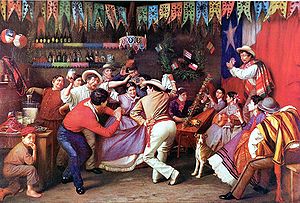
Cueca
Encyclopedia

Chile
Chile ,officially the Republic of Chile , is a country in South America occupying a long, narrow coastal strip between the Andes mountains to the east and the Pacific Ocean to the west. It borders Peru to the north, Bolivia to the northeast, Argentina to the east, and the Drake Passage in the far...
, Bolivia
Bolivia
Bolivia officially known as Plurinational State of Bolivia , is a landlocked country in central South America. It is the poorest country in South America...
, Peru
Peru
Peru , officially the Republic of Peru , is a country in western South America. It is bordered on the north by Ecuador and Colombia, on the east by Brazil, on the southeast by Bolivia, on the south by Chile, and on the west by the Pacific Ocean....
, and Argentina
Argentina
Argentina , officially the Argentine Republic , is the second largest country in South America by land area, after Brazil. It is constituted as a federation of 23 provinces and an autonomous city, Buenos Aires...
. In Chile, the cueca holds the status of national dance, where it was officially selected on September 18, 1979.
Origins

Spain
Spain , officially the Kingdom of Spain languages]] under the European Charter for Regional or Minority Languages. In each of these, Spain's official name is as follows:;;;;;;), is a country and member state of the European Union located in southwestern Europe on the Iberian Peninsula...
and Africa
Africa
Africa is the world's second largest and second most populous continent, after Asia. At about 30.2 million km² including adjacent islands, it covers 6% of the Earth's total surface area and 20.4% of the total land area...
n influences, among others. The most widespread version of its origins relates it with the zamacueca
Zamacueca
The Zamacueca is an ancient colonial dance that originated in the Viceroyalty of Peru, taking its roots from African, Spanish, and Andean rhythms...
which arose in Peru
Peru
Peru , officially the Republic of Peru , is a country in western South America. It is bordered on the north by Ecuador and Colombia, on the east by Brazil, on the southeast by Bolivia, on the south by Chile, and on the west by the Pacific Ocean....
as a variation of Spanish Fandango
Fandango
Fandango is a lively couple's dance, usually in triple metre, traditionally accompanied by guitars and castanets or hand-clapping . Fandango can both be sung and danced. Sung fandango is usually bipartite: it has an instrumental introduction followed by "variaciones"...
dancing with criollo and African influences. The dance is then thought to have passed to Chile
Chile
Chile ,officially the Republic of Chile , is a country in South America occupying a long, narrow coastal strip between the Andes mountains to the east and the Pacific Ocean to the west. It borders Peru to the north, Bolivia to the northeast, Argentina to the east, and the Drake Passage in the far...
and Bolivia
Bolivia
Bolivia officially known as Plurinational State of Bolivia , is a landlocked country in central South America. It is the poorest country in South America...
, where its name was shortened and where it continued to evolve. Due to the dance's popularity in the region, the Peruvian evolution of the zamacueca was nicknamed "la chilena", "the Chilean", due to similarities between the dances. Later, after the Pacific War
Pacific War
The Pacific War, also sometimes called the Asia-Pacific War refers broadly to the parts of World War II that took place in the Pacific Ocean, its islands, and in East Asia, then called the Far East...
, the term marinera
Marinera
Marinera is a coastal dance of Peru, generally called the "National Dance of Peru." Marinera is a graceful and romantic couple's dance that uses handkerchiefs as props. The dance is an elegant and stylized reenactment of a courtship, and it shows a blend of the different cultures of Peru...
, in honor of Peru's naval combatants and hostile attitude towards Chile was used in place of "la chilena." The Marinera
Marinera
Marinera is a coastal dance of Peru, generally called the "National Dance of Peru." Marinera is a graceful and romantic couple's dance that uses handkerchiefs as props. The dance is an elegant and stylized reenactment of a courtship, and it shows a blend of the different cultures of Peru...
, Zamba and the Cueca have different styles that distinct them from each other and their "root" which is the zamacueca.
Another theory is that Cueca originated in the early 19th century bordellos of South America, as a pas de deux facilitating partner finding.
The usual interpretation of this courting dance is zoomorphic: it tries to reenact the courting ritual of a rooster
Rooster
A rooster, also known as a cockerel, cock or chanticleer, is a male chicken with the female being called a hen. Immature male chickens of less than a year's age are called cockerels...
and a hen
Chicken
The chicken is a domesticated fowl, a subspecies of the Red Junglefowl. As one of the most common and widespread domestic animals, and with a population of more than 24 billion in 2003, there are more chickens in the world than any other species of bird...
. The male displays a quite enthusiastic and at times even aggressive attitude while attempting to court the female, but the dance often finishes with the man kneeling on one knee, with the woman placing her foot triumphantly on his raised knee.
Clothing and Dance
The clothing worn during the cueca dance is very traditional Chilean clothes. The men in the dance wear the huaso's hat, shirts, flannel poncho, riding pants and boots, short jacket, riding boots, and spurs. Women wore flowered dresses with an apron. (spotlightonchile.com) The dance of the cueca is done with a sense of the rooster and the chicken. The man approaches the woman and offers his arm, then the women accompanies him and they walk around the room. They then face each other and hold their handkerchief in the air, and being to dance. They never touch, but still maintain contact through facial expressions and movements. The white handkerchief must be waved; this writer has seen Chileans using paper handkerchieves from a box rather than dance the cueca without one.(spotlightonchile.com)Basic structure
The basic structure of the cueca is that it is a compound meter in 6/8 or 3/4 and is divided into three sections.Some differences can be noticed depending on geographical location. There are three distinct variants in addition to the traditional cueca:
- The northern cueca: The main difference with this version is that there is no singing in the accompanying music which is played with only sicus, zamponas, and brass. trumpetTrumpetThe trumpet is the musical instrument with the highest register in the brass family. Trumpets are among the oldest musical instruments, dating back to at least 1500 BCE. They are played by blowing air through closed lips, producing a "buzzing" sound which starts a standing wave vibration in the air...
s, tubaTubaThe tuba is the largest and lowest-pitched brass instrument. Sound is produced by vibrating or "buzzing" the lips into a large cupped mouthpiece. It is one of the most recent additions to the modern symphony orchestra, first appearing in the mid-19th century, when it largely replaced the...
s. Also, both the music and the dance are slower. This dance is done during religious ceremonies and carnival. (www.guitarrachilena.cl.php).
- The cueca from the central region: This genre is mostly seen in Chile. The guitar, accordion, guitarron, and percussion.
- The ChiloéChiloé ArchipelagoChiloé Archipelago consists of several islands lying off the coast of Chile. It is separated from mainland Chile by Chacao Channel in the north, the Sea of Chiloé in the east and Gulf of Corcovado to the southeast. All of the archipelago except Desertores Islands, which are part of Palena...
cueca: This form has the absence of the cuarteta. The seguidilla are repeated and there is a greater emphasis on the way the lyrics are presented by the vocalist.
Today
Currently, the cueca is mainly danced in the countryside, and performed throughout Chile each year during the national holidaysFiestas Patrias (Chile)
The Fiestas Patrias of Chile consists of two days:*September 18, in commemoration of the proclamation of the First Governing Body of 1810, and marking the beginning of the Chilean independence process....
in September. Dancing competitions of cueca are popular around that time of year.
In Bolivia there are lots of different Cueca styles according to the region: Cueca Paceña, Cueca Cochabambina, Cueca Chuquisaqueña, Cueca Tarijeña, Cueca Potosina y Cueca Chaqueña. What they have in common is their rhythm, but they differ quite a lot in velocity, costumes and style. The Cueca styles of La Paz
La Paz
Nuestra Señora de La Paz is the administrative capital of Bolivia, as well as the departmental capital of the La Paz Department, and the second largest city in the country after Santa Cruz de la Sierra...
, Potosí
Potosí
Potosí is a city and the capital of the department of Potosí in Bolivia. It is one of the highest cities in the world by elevation at a nominal . and it was the location of the Spanish colonial mint, now the National Mint of Bolivia...
and Sucre
Sucre
Sucre, also known historically as Charcas, La Plata and Chuquisaca is the constitutional capital of Bolivia and the capital of the department of Chuquisaca. Located in the south-central part of the country, Sucre lies at an elevation of 2750m...
are the elegant ones, whereas in Cochabamba
Cochabamba
Cochabamba is a city in central Bolivia, located in a valley bearing the same name in the Andes mountain range. It is the capital of the Cochabamba Department and is the fourth largest city in Bolivia with an urban population of 608,276 and a metropolitan population of more than 1,000,000 people...
and Tarija
Tarija, Bolivia
Tarija or San Bernardo de la Frontera de Tarixa is a city in southern Bolivia. Founded in 1574, Tarija is both the capital and largest city within the Tarija Department, with an airport offering regular service to primary Bolivian cities, as well as a regional bus terminal with domestic and...
the style is much more lively.In Bolivia, it is usually called "Cuequita Boliviana"

